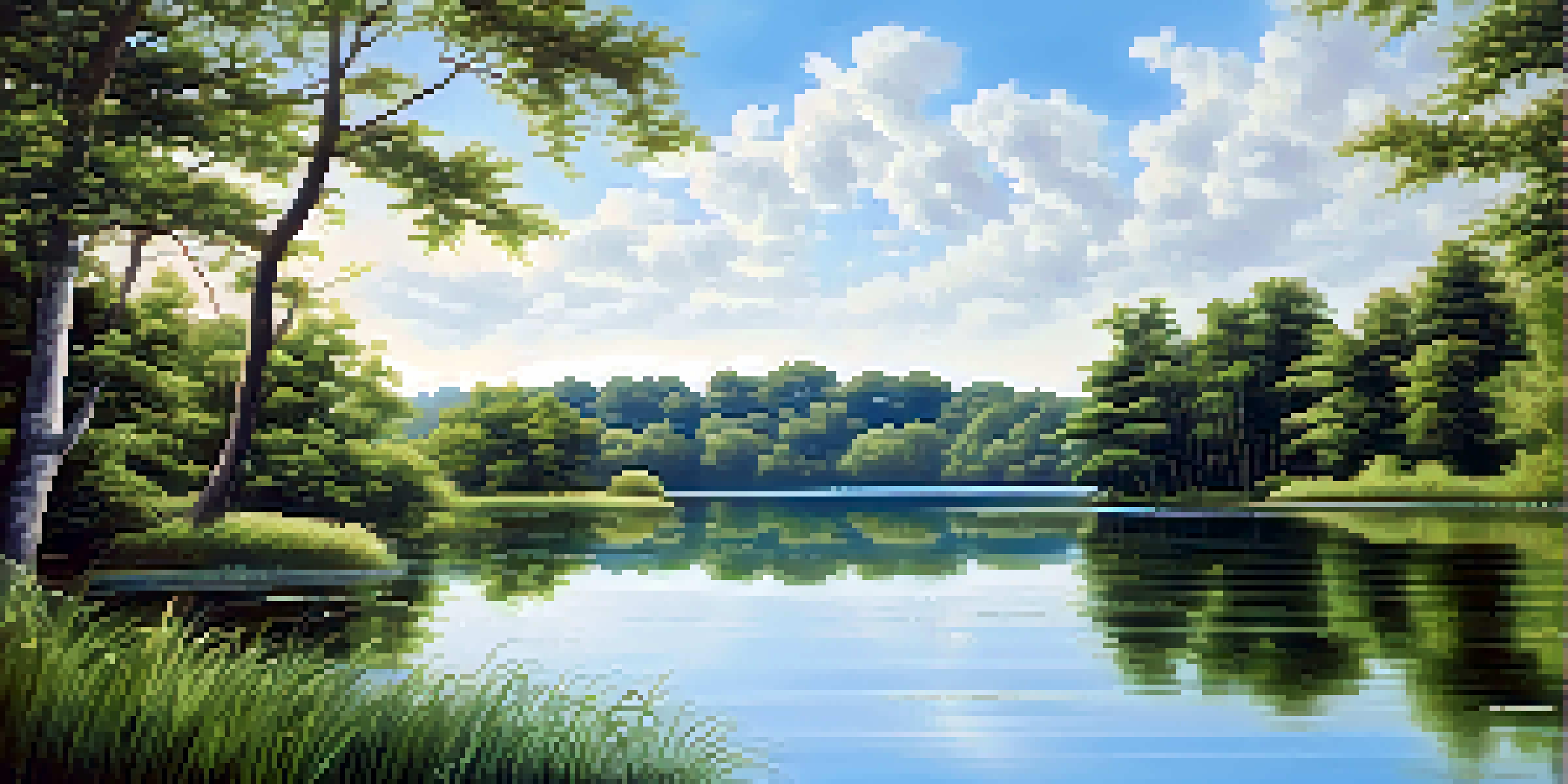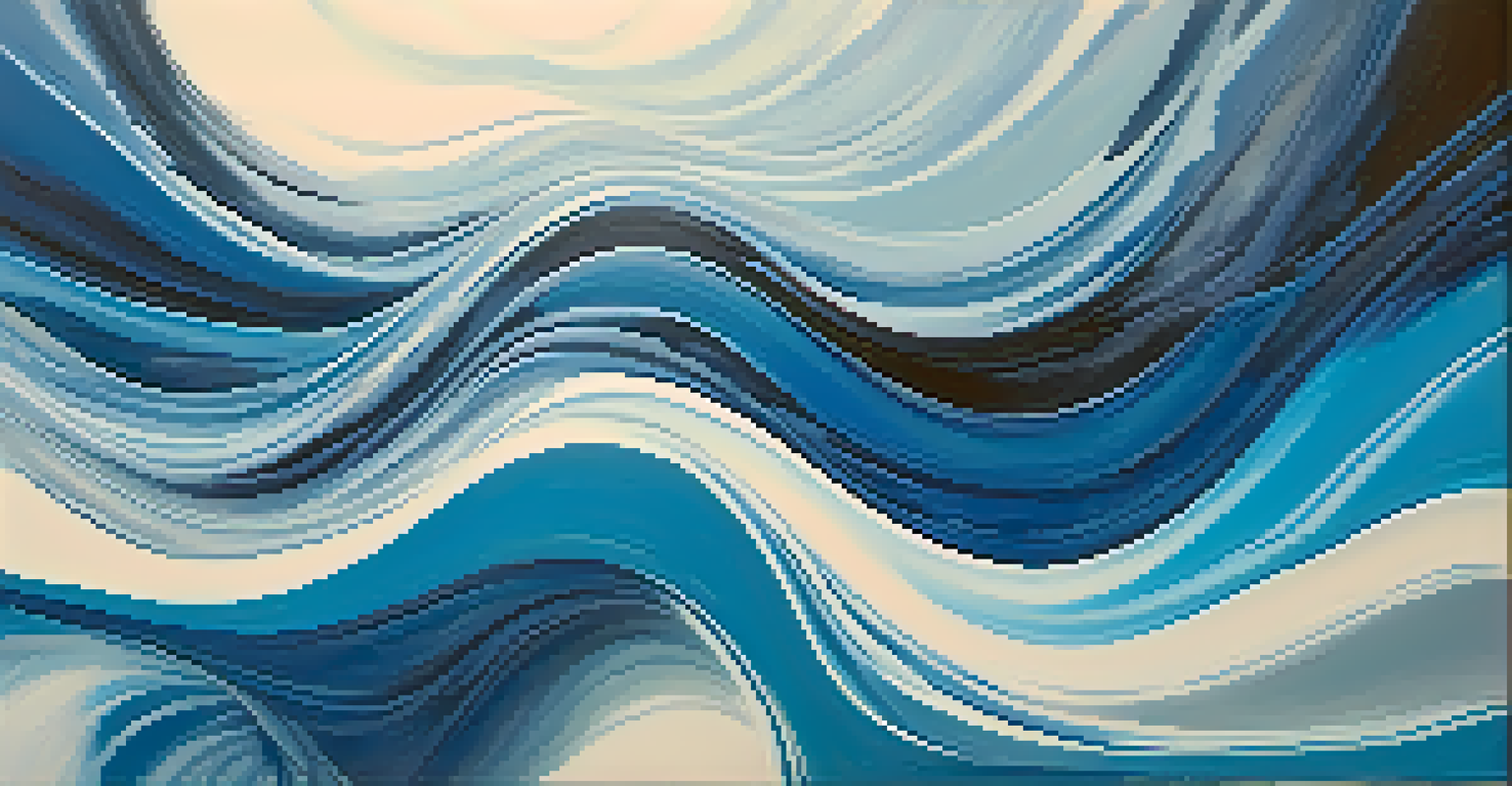Blue Hues: Calming Effects of Color in Artistic Expressions

The Psychological Impact of Blue in Art
Color psychology suggests that blue is often associated with calmness and tranquility. It’s no surprise that artists incorporate blue hues to evoke these feelings in their audiences. When we see blue, whether in nature or art, it can trigger a sense of peace, almost like a gentle breeze on a warm day.
Color is the keyboard, the eyes are the harmonies, the soul is the piano with many strings.
Many artists, from Picasso to Van Gogh, have utilized blue in their works to communicate emotions. Van Gogh's 'Starry Night' features deep blues that create a serene nighttime atmosphere, inviting viewers to immerse themselves in a world of calm reflection. This use of color illustrates how art can transcend its visual boundaries to impact our emotional state.
Moreover, blue is often linked to feelings of stability and reliability. This sense of security can be comforting, reminding us of clear skies or vast oceans. Thus, artists tapping into blue hues are not just creating visually appealing pieces; they’re fostering an emotional connection that resonates deeply with viewers.
Cultural Associations with the Color Blue
Throughout history, cultures have attributed various meanings to the color blue. For instance, in many Western cultures, blue is connected with tranquility and trust. In contrast, in some Eastern cultures, it can symbolize immortality and spirituality, showcasing the diverse interpretations of this color.

Artists often draw on these cultural associations to enrich their work. A piece featuring blue might resonate differently with audiences based on their cultural backgrounds. This interplay between color and culture highlights how art can be a universal language that speaks to varied experiences.
Blue Evokes Calm and Serenity
The color blue is widely recognized for its ability to promote feelings of calmness and tranquility across various forms of art.
Understanding these associations can deepen our appreciation for art. When viewing a painting dominated by blue, we might consider not only the artist's intention but also our personal and cultural interpretations of the color. This multifaceted approach adds layers of meaning to artistic expressions.
The Role of Blue in Landscape Art
Landscape artists frequently employ blue hues to depict skies and bodies of water, creating a sense of depth and perspective. The vastness of a blue sky can evoke feelings of freedom and openness, making the viewer feel as if they are part of the scenery. This connection to nature can be incredibly soothing.
The color blue has a special meaning in our culture, representing depth, trust, and a sense of calm.
Consider the works of artists like Claude Monet, who captured the calming effects of blue in his water lily paintings. The serene blue water reflects light and creates a peaceful ambiance that invites the viewer to linger in a moment of tranquility. Such artworks remind us of the beauty found in nature, drawing us into a meditative state.
Additionally, blue hues in landscapes can symbolize distance and mystery. The fading blues of distant mountains create a sense of longing or nostalgia, engaging viewers on an emotional level. This emotional engagement is a powerful aspect of why blue is so effective in landscape art.
Blue in Abstract Art: An Emotional Journey
Abstract artists often use blue as a primary color to explore complex emotions. The freedom of abstraction allows artists to experiment with shapes and forms, creating a visual language that speaks directly to the heart. Blue, with its calming qualities, can anchor these emotional explorations.
Take the works of artists like Mark Rothko, whose color field paintings often feature deep blues. These pieces create immersive environments, inviting viewers to connect with their inner emotions. The simplicity of color combined with the depth of feeling illustrates how blue can serve as a powerful conduit for emotional expression.
Cultural Meanings of Blue Vary
Different cultures attribute unique meanings to blue, enriching the emotional and interpretative experience of art.
This journey through abstraction shows us that blue is more than just a color; it’s a gateway to understanding our feelings. By immersing ourselves in abstract works that utilize blue, we can experience a meditative state that encourages self-reflection and calm.
Blue in Modern Digital Art: A New Medium
As we move into the digital age, blue continues to play a vital role in modern art forms. Digital artists use blue hues to create immersive experiences, often reflecting the calming effects of traditional art while harnessing new technology. This evolution shows the adaptability of color in artistic expression.
For example, in digital installations, artists can manipulate shades of blue, creating dynamic environments that shift and change. This interactive experience allows viewers to engage with the color on a personal level, enhancing the calming effects as they explore these virtual landscapes. The blend of technology and color opens up new avenues for emotional engagement.
Moreover, the accessibility of digital art means that audiences worldwide can experience the soothing effects of blue. Whether through a digital painting or an interactive installation, the calming properties of blue remain a powerful tool for artists, continually resonating with viewers across different mediums.
The Therapeutic Use of Blue in Art Therapy
Art therapy often incorporates blue to promote relaxation and emotional healing. The calming effects of this color can help individuals express their feelings in a safe and creative environment. By using blue in their artistic expressions, participants can find solace and clarity during difficult times.
Therapists encourage clients to explore their emotions through blue hues, often helping them to visualize their feelings. This process not only facilitates emotional release but also fosters a sense of peace and stability. The therapeutic properties of blue can be particularly beneficial in addressing anxiety and stress.
Blue in Art Therapy Promotes Healing
In art therapy, blue is utilized to facilitate emotional expression and healing, offering a sense of peace during challenging times.
As art therapy continues to evolve, the use of blue remains a cornerstone for many practitioners. By harnessing the calming effects of this color, therapists can guide individuals on their journey toward emotional well-being, showing how art can be both a creative outlet and a source of healing.
Conclusion: Embracing the Power of Blue in Art
In conclusion, blue hues possess a unique ability to evoke calmness and serenity across various artistic expressions. From traditional paintings to modern digital art, the emotional resonance of blue is undeniable. Artists harness this power to create works that not only please the eye but also soothe the soul.
Whether through cultural associations, psychological impacts, or therapeutic applications, blue continues to shape our experience of art. It invites us to reflect, connect, and find peace in a world that can often feel chaotic. Embracing the calming effects of blue can enhance our appreciation for art and the emotions it conveys.

As you explore art, take a moment to notice the use of blue and how it makes you feel. This simple awareness can transform your viewing experience, allowing you to appreciate the deeper emotional layers that color brings to artistic expressions.